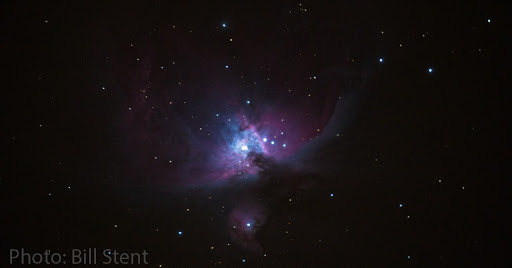Great Nebula in Orion
This one is one of my early goes using
a DSLR, which I still think was pretty good.
Orion is imagined as a hunter having a belt of three stars, from which hangs a sword of thee stars. In the Southern Hemisphere, of course, he's standing on his head, so the sword is above the belt. Here's a Stellarium map.
In the Southern Hemisphere, the pattern is sometimes known as "the saucepan", so for "belt and sword", read "base and handle".
The Nebula itself is easy to find. Round Christmas, find the "belt" stars, and then find the three sword stars. Now look carefully at the middle sword star. It isn't a star. That's the nebula. Yes, it's so bright you can see it with the naked eye - even in mildly light polluted areas.
The problem for photographers is that it's so hard to get right. I've never quite nailed it. While it's really bright in the middle, it goes out and out and out, getting dimmer and dimmer all the while. If you set up the photo to get the middle right, you lose the outer fringes. If you expose for the dim outer bits, you overexpose the bright bits and lose the "trapezium", those four stars right in the middle.
Last year I tried to be clever and compensate for all the different brightness areas to show the whole thing. Ideally, the photo should look dramatic and threatening, with the inner area becoming higher and higher contrast, drawing you in like a maze.
Mine just looked blah, all pretty much the same.
I was talking about it last night with an astrophotographer mate, and I found I'd hated my image so much I'd deleted it.
This final one is the Hydrogen alpha layer from
last year's effort. It just picks up the light from ionised hydrogen in the nebula.



Comments
Post a Comment